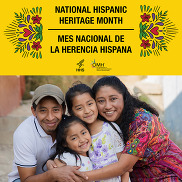
September 15 – October 15 is National Hispanic Heritage Month! This annual observance is an opportunity to celebrate the achievements, histories, traditions, diversity, and vibrant culture of Hispanic and Latino Americans.
The U.S. Department of Health and Human Services (HHS) Office of Minority Health (OMH) is committed to working with public health and community-based partners to Be the Source for Better Health by providing Hispanics/Latinos with quality, equitable, and respectful care and services that are responsive to their diverse cultural health beliefs and practices, preferred languages, economic and environmental circumstances, and health literacy levels.
Certain social and economic circumstances known as social determinants of health (SDOH) can impact Hispanic/Latino health outcomes and leave them at increased risk for many preventable health problems. Delaying medical care due to cost, limited social support, and experiencing food insecurity are all examples of adverse SDOH factors that can lead to negative health outcomes for Hispanics/Latinos.
Visit the OMH National Hispanic Heritage Month 2024 website to find bilingual resources and materials on Hispanic/Latino health, shareable graphics, social media messaging, and virtual backgrounds. Use OMH's National Hispanic Heritage Month infographic to raise awareness about the SDOH impacting Hispanic/Latino population.
|
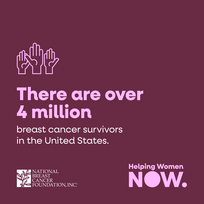
October is National Breast Cancer Awareness Month. Breast cancer is the second most common cancer among women in the United States after skin cancer. This month is devoted to educating everyone about breast cancer and the importance of early detection and access to timely, high-quality care.
According to the National Breast Cancer Foundation (NBCF), in 2024, more than 360,000 people will be diagnosed with breast cancer. While the rate of breast cancer diagnosis is lower for Black women than for white women, Black women have a higher breast cancer death rate than any other racial or ethnic group in the United States.
Use and share these tips from the Susan G. Komen Foundation to understand the warning signs of breast cancer, your risk of breast cancer, and what’s normal for you so you can take action if there are any changes in your body:
-
Know Your Risk: Talk to a doctor about your family history and see how that history impacts your risk of breast cancer. You and your doctor can create a personalized plan to monitor for signs of the disease.
-
Get Screened: For those at average risk, have a mammogram every year starting at age 40. If you have any signs of breast cancer, finding it early and treating it early may save your life.
-
Know Your Normal: It’s important to know what’s normal for you so you can talk with your health care provider if something doesn’t look or feel right.
-
Make Healthy Lifestyle Choices: Living a healthy lifestyle is within your control and may lower your risk of breast cancer. Maintain a healthy weight, limit alcohol intake, and exercise regularly. It all matters when it comes to your overall health and risk of disease.
The Centers for Disease Control and Prevention’s (CDC) National Breast and Cervical Cancer Early Detection Program provides breast cancer screenings to low-income, uninsured, and underinsured women. The program is available through state and territorial health departments and Tribal organizations. Find your state's, territory's, or Tribe's program here.
Visit CDC’s Breast Cancer Awareness webpage to learn more about breast cancer risk factors, symptoms, and early detection procedures like mammograms.
|
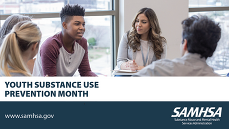
The month of October is National Youth Substance Use Prevention Month — a time for communities to come together as partners in prevention. This month is also a time to acknowledge those in recovery, as well as the children, parents, family, and friends supporting them.
According to the 2023 National Survey on Drug Use and Health from the Substance Abuse and Mental Health Services Administration (SAMHSA), nearly 2.2 million youth ages 12 to 17 had a substance use disorder. In 2023, multiracial (12.0%), Hispanic or Latino (8.2%), and Black or African American (7.5%) adolescents ages 12 to 17 had higher rates of illicit drug use in the past year than other racial and ethnic minorities.
SAMHSA’s national youth substance use prevention campaign, "Talk. They Hear You."®, helps parents and caregivers, educators, and community members get informed, be prepared, and take action to prevent underage drinking and other substance use.
Use these Substance Use Prevention Resources for Youth and College Students to educate about substance misuse and promote substance use prevention in the month of October and all year long. The toolkit contains resources, social media messages, graphics, and other materials to help bring awareness to substance use prevention.
|
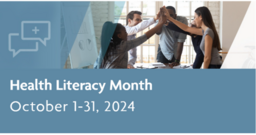
October is Health Literacy Month, a time to recognize the importance of making health information easy to understand and the health care system easier to navigate. This observance calls on health organizations, literacy programs, libraries, businesses, government agencies, and other groups to work together to integrate and expand the mission of health literacy.
Healthy People 2030 defines health literacy as the degree to which individuals can find, understand, and use information and services to inform health-related decisions and actions for themselves and others. In 2018, Approximately 80 million adults in the United States were estimated to have low or limited health literacy.
When people don’t understand health information, they are less likely to seek preventive health services and more likely to have health problems. It's important that health care providers help patients understand health information, especially for populations that have historically had low health literacy rates. In 2021, Black and Hispanic adults had the highest proportion of patients whose health care provider checked their understanding (35.8% each) while white (23.3%) and Asian (24.7%) adults had the lowest.
Advancing health literacy can improve health outcomes, health care safety and quality, and reduce health disparities and health care costs. Explore resources from HHS agencies to learn more about health literacy. Check out the OMH Think Cultural Health website for more information on how to provide effective communication that considers the cultural, health literacy levels, and language needs of the populations you work with.
|

As the fall and winter season approaches, now is the time to prepare yourself and your loved ones for the upcoming flu season. CDC recommends everyone ages 6 months and older receive an updated 2024-2025 COVID-19 vaccine to protect against COVID-19 this fall and winter, whether they have ever previously been vaccinated with a COVID-19 vaccine or not.
It is safe to receive COVID-19 and flu vaccines at the same visit. Check out the CDC website for what to know about getting flu, COVID-19, and RSV vaccines at the same time and find pharmacies near you that offer vaccines.
While vaccines are your best protection against common respiratory illnesses, it's also important to take preventative measures to lower the spread of infection, including:
-
Wash your hands: Wash your hands well and often with soap and water for at least 20 seconds. Make sure friends and family whom you're around regularly, especially kids, know the importance of handwashing.
-
Avoid touching your face: Keeping your hands away from your eyes, nose, and mouth helps keep germs away from those places.
-
Cover your coughs and sneezes: Cough or sneeze into a tissue or your elbow. Then wash your hands.
-
Clean surfaces: Regularly clean often-touched surfaces to prevent the spread of infection from touching a surface with the virus on it and then your face.
-
Avoid crowds: The flu spreads easily wherever people gather. By avoiding crowds during peak flu season, you lower your chances of infection.
Celebrate Global Handwashing Day on October 15 to raise awareness about the importance of handwashing. The 2024 Global Handwashing Day theme, Why are clean hands still important?, highlights handwashing with soap and water as one of the simplest, most effective ways to stop the spread of germs and stay healthy. This is especially important for racial and ethnic minority populations that are disproportionally affected by illnesses like the flu and COVID-19.
This cold and flu season, use these CDC resources and materials to help you promote handwashing in your community, and download and share materials from CDC's national handwashing campaign, Life is Better with Clean Hands.
|
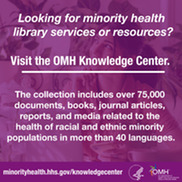
In honor of National Latinx AIDS Awareness Day on October 15, the OMH Knowledge Center is sharing a collection of recent articles focused on the disproportionate impact of HIV on Hispanic and Latino communities. The collection’s topics touch on promoting HIV tests, prevention, treatment, and reducing HIV/AIDS stigma to stop HIV transmission.
You can access this collection through the OMH Knowledge Center online catalog.
|
|